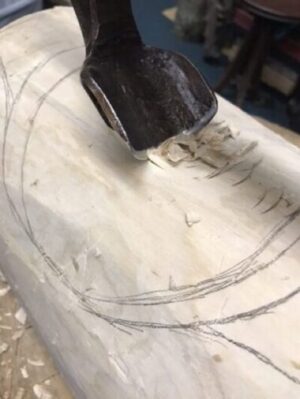Carving a bowl – The Adze
Optimally, carving a bowl requires green wood. The tender wood is still moist enough to yield to sharp tools like axes, adzes, and carving knives. Subsequent moisture release and shrinkage is part of the plan for prepping further work on the project. A shrink pot is a good example. Harder wood that’s been in the shop for a while will work, but it requires a little more effort.
The work continues
In the previous post, I prepared a small log for making a bowl. I didn’t have green wood so I used a log that had been in the shop for a while. One side already had been removed during riving with the restored froe. That saved the effort of splitting the log. Now the rest of the log had to be debarked. Then, I began the task of hollowing the debarked curved side with an adze.
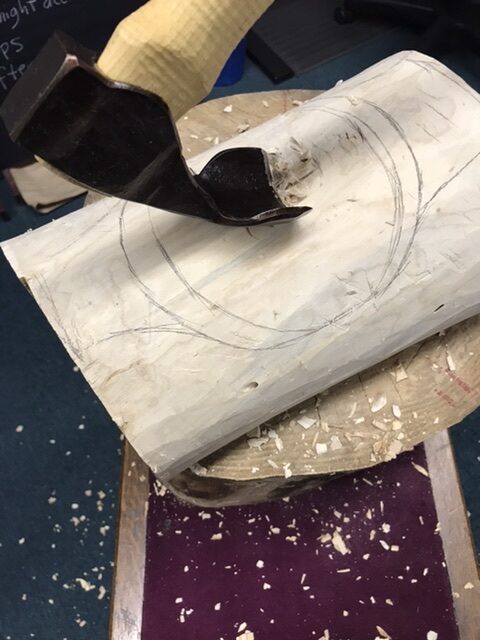
That wood, a street find, was quite hard!
Loosely marking the bowl design in the wood helps direct the hewing strikes. It keeps the adze from haphazardly landing on the bowl. Like darts, controlled landing near the target is acceptable. Carving a bowl by chipping out material is the primary goal.
It’s Never Simple
Traditionally, carving a bowl or hewing with an adze is not accomplished by simply striking the log. It brings to mind a sobering memory of saxophone lessons I took years ago. A saxophone player produces sound through formation of an embouchure with the tongue on a reed – not just an unharnassed blast of breath. It was not an easy concept to execute – at least for me. The adze swing or throw is finessed similarly.
Let’s take a look:
This looks more like proper handling of the tool. Let’s see what we’re getting. Chips of wood leap out of the cavity after the adze strikes. I’ll try to explain it plainly.
If it can be managed, a delicate movement is used. Instead of forcefully striking the log, the adze is handily cast or lobbed onto the wood. It takes one “bite” after another into the ever-widening bowl cavity. This is done with a loose grip that allows the adze head to swing or catch a wave, leaving chips and shavings. At this point, it swings subtly from the fingers and feels as though it will fall out of your hand.
The adze head simply rides the curvature of the widening cavity and follows through and off the end of the cut…. when it can. Each cut is adapted to the space, the nature of the wood, and the woodworker’s energy remaining to wield the tool.
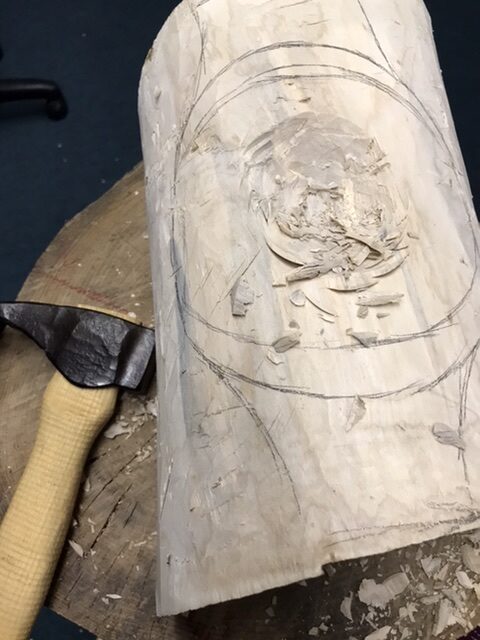
Awareness of factors, such as the quality and nature of the wood and time allotted for the project may require a stronger chopping action. In these rare cases, a swing is just a swing!
And this is why I don’t play saxophone today! Oh well, I’m settled down now.
What is That?
I see a small area that appears to be over a possible hollow spot in the log’s core. This needs to be investigated, but how can I tell? First, I’ll observantly chop with the adze. After each chop, errant chips flying off at a rate faster than the rest of the cavity chips may provide a clue. Then, from time to time, I’ll evaluate the texture and strength of the spot with my fingers. If the spot gives way with pressure, that is a clear sign that it may break through.
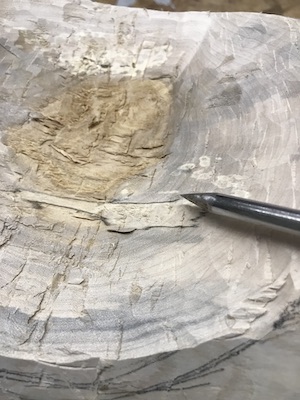
playing tricks on my eyes?
How I’ll handle this, I am not sure. It may be an area eaten out by insects.
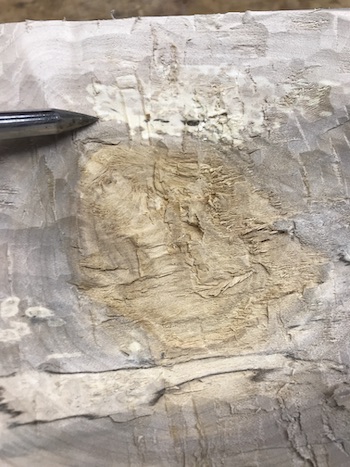
After all I found the log in my after-storm street wanderings! Much of the time, fallen trees are already weakened by disease which makes them susceptible to environmental forces.
An Unexpected Find
Was the suspected spot in the cavity caused by insects or simply a pattern created by interlocking grain?
Well, the breakdown of the surface did not occur where I suspected. I was fooled by the grain which produced an optical illusion that eventually disappeared as the cavity deepened.
When I chopped away in the cavity, however, a hole – a real one – broke through in the pith.
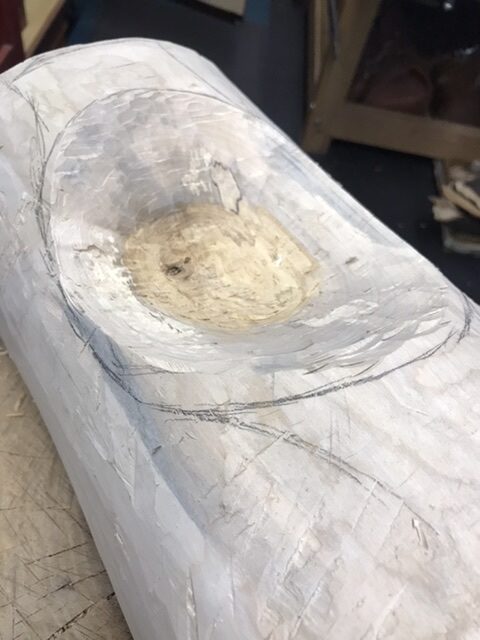
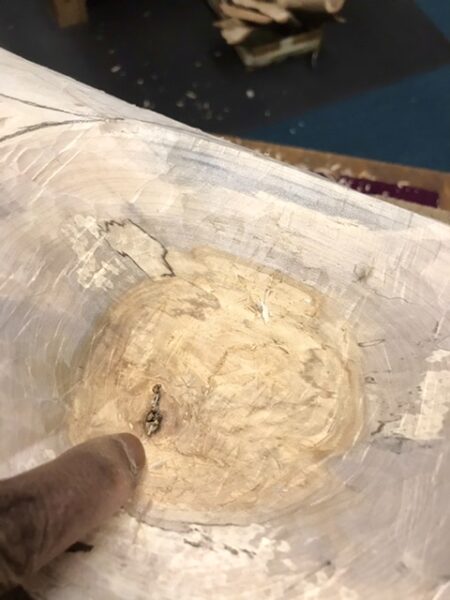
Right now it is small but the area around it needs to be cleaned up. I will use the adze and a gouge chisel to level the space.
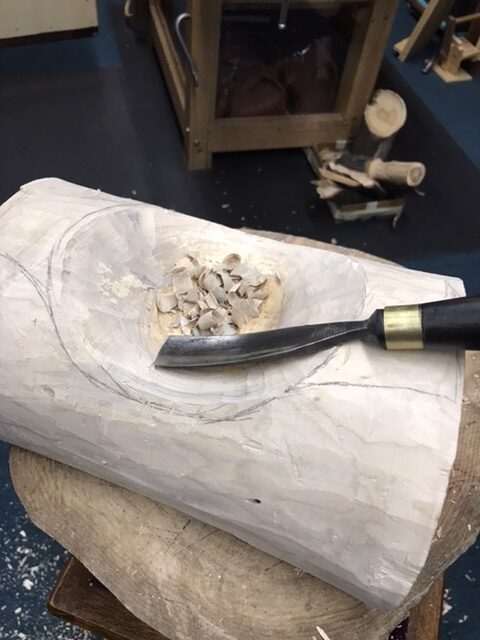
While I work, I am thinking of a way that the hole, an incidental flaw, can be used in the bowl design. This just may be an opportunity to employ the concept of wabi-sabi and a little creativity… or not.
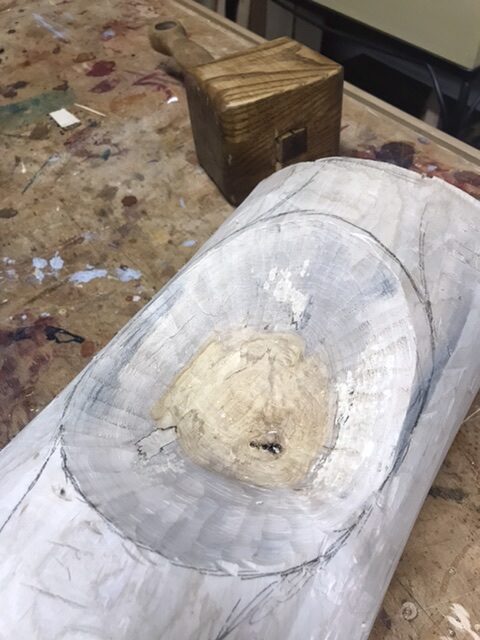
A bit more shaving will tell.
__________
Next time: the rest of the bowl takes shape
Baadaye
Shirley J ♥️

